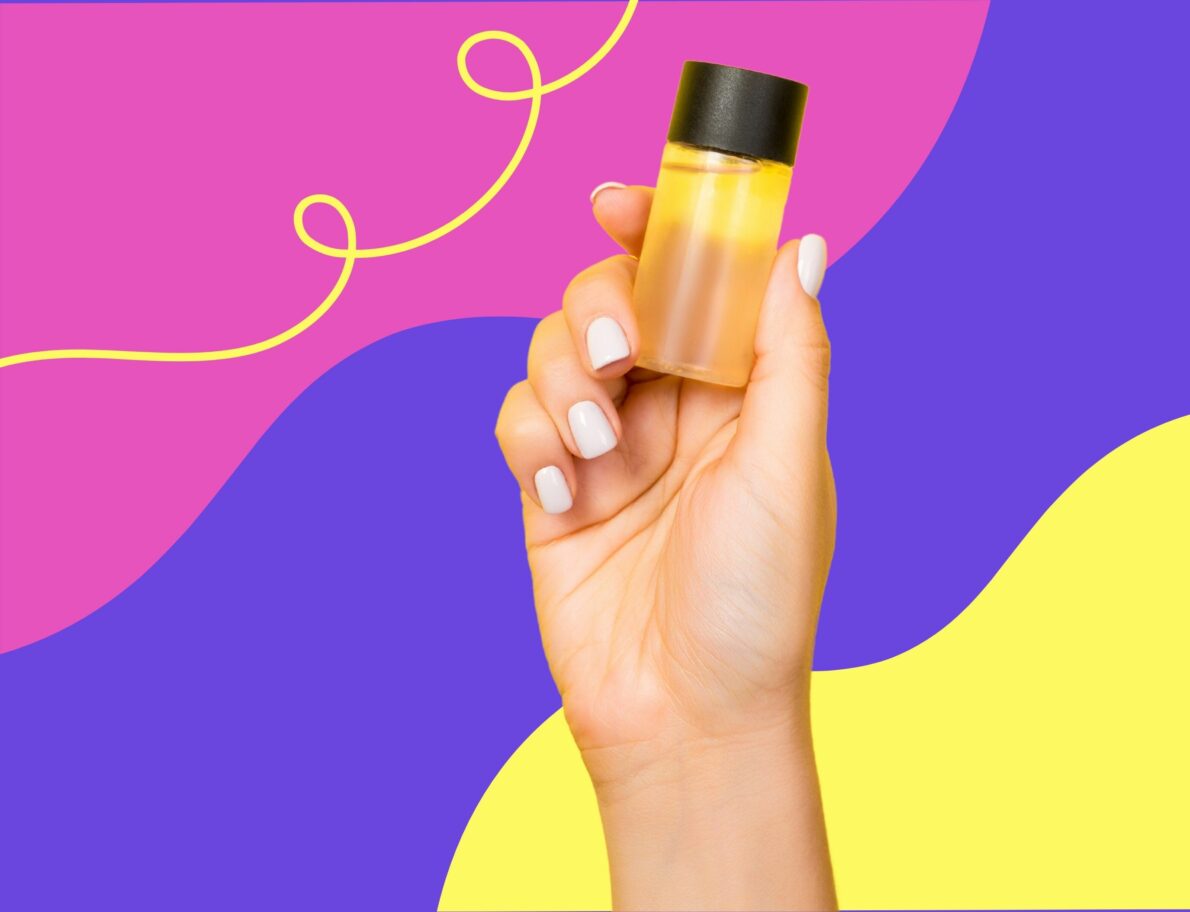What you’ll learn
Tired of seeing potential customers bounce off your product pages faster than Taylor Swift tickets on release day? We get it—it’s like a punch to the gut.
Mastering the art of how to write product descriptions that convert can feel like trying to get a perfectly imperfect messy bun—tricky at first, but oh-so-fabulous once you get it right. It’s a cocktail of strategy and finesse: think product information with a dash of storytelling, personality without the fluff, and the right touch of SEO as the cherry on top.
After all, you’ve poured blood, sweat, and maybe even a few tears into perfecting your offerings, and yet the sales just aren’t rolling in. Your web design’s on point, your product pics are slaying—so what gives?
The missing link in your sales chain might be your product descriptions.
With our pack leader Christina Lyon’s nuggets of wisdom, we’re here to help you craft kickass product descriptions, so you can rack in the conversions and kick bounce rates to the curb—where they belong.✌️

How to Write Product Descriptions That Seal the Deal
You’ve probably read a dozen articles about writing effective product descriptions. They all tell you the same thing:
- Be clear and concise
- Sprinkle in on-page SEO
- Focus on pain points
- Use profesh product images
- Highlight product features
- Use bullet points to make it easy-breezy
While these are definitely essential components of solid descriptions, checking only these boxes would meet the absolute bare minimum. And that’s how brands blend into the crowd and become, well, forgettable. 😶🌫️
At Lyon Content, we’re not content hitting the status quo; our bullseye is on skyrocketing your sales game and making you a cult sensation. That means it’s about more than merely writing effective product descriptions—it’s about making them actionable and irresistible AF.
Here’s how Christina puts it:
“Simply listing product features with zero storytelling is a common mistake. I see this all the time, and often from large brands. Another faux pas? The long-winded, flowery language that says nothing at all about product benefits. There’s a delicate finesse that comes with practice, repetition, and creative thinking.”
She says you should also ensure each description is artfully optimized because keyword stuffing completely undermines credibility. The trick is to differentiate your product from competitors, and the best way to do that is to deeply understand your audience’s problem, lead with empathy, offer value, and spin a great story.
The bottom line: a good product description can close the sale, but a great product description wins you a customer for life.
Your first move? Get crystal clear on who you’re speaking to. 📣
Use Target Audience Insights to Write Product Descriptions
The key to crafting a product description that’s truly out of this world means knowing your target audience like the back of your hand.
You’ve gotta zero in on who your ideal customers are—their age, where they live, what they like and dislike, and their pain points. This is where market research comes into play.
Sooo, like surveys and polls, right?
Not necessarily. Christina says those strategies are better suited for more established brands who’ve already amassed a sizable following. If you’re just stepping onto the field, you want to focus on grassroots tactics like social listening or customer interviews to really solidify who your target audience is.
“Market research always starts with digging into the demographics of existing and goal clients. Track down juicy insights on discussion platforms like Reddit or Quora, and creep the comments sections in social spaces where potential audiences spend time. Then distill all that intel into your brand messaging guide.”
According to Christina, your brand guide is your brand’s bible. It lays down the law on everything from tone and voice to language and messaging.
With a rock-solid guide, you ensure your brand’s essence shines consistently through every piece of content—including product descriptions.
Once you’ve gathered all that data, you’ve got everything you need to tap into your audience’s psyche and craft product descriptions that resonate on a whole new level.
The Psychology Behind Irresistible Product Descriptions
Okay, you’ve done your homework and sifted through mountains of market research. Now what?
It’s time to take all that juicy intel and turn it into product descriptions that inform and entice.
Let’s talk about consumer psychology.
Buyer Personas: The Cheat Sheet to Their Souls

Buyer personas are your secret weapon to understanding the emotional triggers, needs, and desires of your potential customers. When you know what makes them tick, you can craft product descriptions that speak directly to them.
Imagine your ideal customers, sketched out in vivid detail with info like their:
- Ages
- Occupations
- Hobbies
- Pain points
Now go deeper than demographics.
- What are their goals?
- What keeps them up at night?
- What language do they use?
The more specific you can get, the better. Give them titles. (Ours are The Busy Marketer and The Passionate Founder, for example.)
These are your buyer personas, and they’re your compass for crafting product descriptions that echo their interests.
The UVP Equation: Features + Benefits
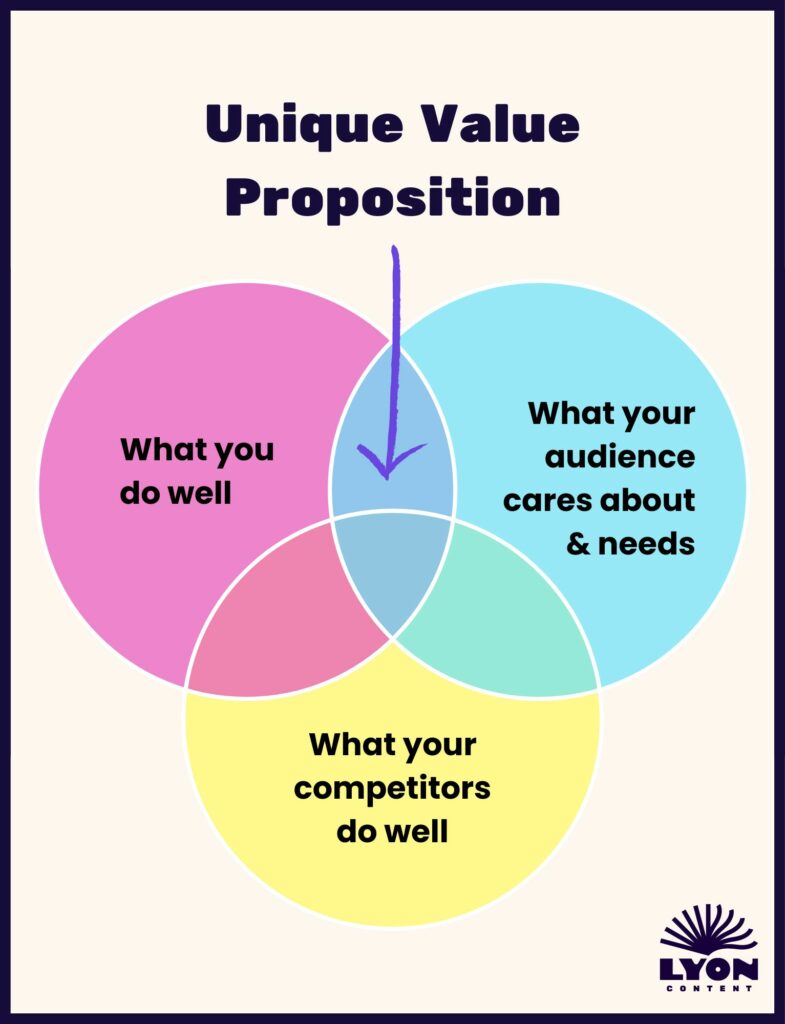
It’s time to dig into the nitty-gritty: your Unique Value Propositions (UVPs). These are the details that set your product apart from the competition. But UVPs go beyond mere features—they’re also framed as benefits to answer the customer’s burning question: “What’s in it for me?”
Christina puts it perfectly:
“Tap into the psychological benefits of the product. Write in the tone designed for your intended audience and hook them in with strong, persuasive copywriting.”
She emphasizes the importance of listing features and explaining how they translate into benefits. Will your product save them time? Make them feel more confident? Solve a problem they didn’t even know they had? That’s the gold you want to mine.
So, how do you do that? She suggests starting with a magnetic story that grabs attention and then listing the features in an easily navigable format.
Simple, yet effective.
Storytelling: the Emotional Glue
Thought we were stopping at features and benefits? Oh no.
Christina believes storytelling is the emotional glue that binds your audience to your brand. It’s about taking your content beyond SEO and creating a genuine connection with them.
Lead with empathy, weave a narrative that resonates, and make your product descriptions readable and relatable.
“You need to know what’s driving their search, which takes strategic SEO and keyword research to learn what phrases and terms they’re typing into search engines. Then, distill that data to ensure it’s relevant and applicable to their problem and your solution.”
That means putting yourself in their shoes and typing into Google what you think they’re typing into Google. That’s how you’ll find an abundance of questions and long-tail keywords that shape your narrative.
When you blend all these elements seamlessly, you accomplish so much more than mastering how to write product descriptions—you’re mastering how to create an experience. An experience so magnetic, your customers will hit “Add to Cart” feeling like they’ve just found the thing they’ve been missing all along.
Another tip for crafting irresistible product descriptions? They need to tick every essential box and then some. ✅
10 Must-Haves Every Product Description Needs
By now, you’ve learned that a killer product description is way more than a laundry list of specs—it’s an intentionally crafted narrative that showcases your product and vibes with your audience. It’s the difference between a one-night stand and a long-term relationship with your customers…err, you know what I mean.😅
After almost a decade of elevating beauty and lifestyle brands through captivating written content, we’ve cracked the code on product descriptions that truly deliver (and we’ve got the accolades to prove it).
Here’s Christina’s 10-step formula for high-impact product descriptions:
- Product Name: Make it snappy, compelling, and relevant.
- Hook: Write a catchy, attention-grabbing hook summarizing your product and why your audience needs it.
- Feature Bullets: These are your specs. List the technical features of your product in easy-to-digest bullet form.
- Benefit Summary: How will this product improve your customer’s life? Share a story, infuse personality, and flex those persuasive muscles.
- Visuals: Incorporate high-quality images and videos of your product. Showcase multiple angles, shots of your product in action, and close-ups to show texture and detail.
- Social Proof: Real words from real people are incredibly persuasive, so flaunt those rave reviews.
- Call-to-Action (CTA): What do you want your customers to do next? Whether it’s “Add to Cart,” “Learn More,” or “Subscribe,” make it crystal-clear and undeniably tempting.
- Related Products: Suggest other products your audience might be interested in and let the magic of their product descriptions work its charm once more.
- SEO Keywords: Sprinkle relevant keywords throughout the description, but keep it natural. Remember, you’re writing for humans first, search engines second.
- Closing Line: Wrap up your description with something memorable. It could be a guarantee, a loyalty incentive, or a fun sign-off that embodies your brand’s voice.
Once you’ve got these must-haves crossed off, make them your own by incorporating the secret sauce: YOU. Tie in your distinct brand voice and storytelling chops to make your audience feel like they’ve found the missing piece to their puzzle. 🧩
Stuck on square one? Ditch the checklists and creative blocks. With our signature formula, we turn your content headaches into effortless wins. 🦁 #ContentThatRoars
Now, let’s talk about streamlining this process with templates.
Product Description Templates That Work
Product description templates are pre-set outlines or frameworks that serve as a starting point for writing product descriptions.
The main idea? To streamline the writing process by providing a consistent structure you can easily customize for each product. This ensures that all the key points are covered, making it easier to create informative and persuasive descriptions.
Here’s a bare-bones baseline to help you get started:
| Checklist | Example Content |
| ✅ Product Name | Glow-Boosting Vitamin C Serum |
| ✅ Hook | Unlock radiant skin in just one drop. |
| ✅ Feature Bullets | – Infused with 20% Vitamin C- Hyaluronic Acid for hydration- Paraben and sulfate-free- Safe for all skin types |
| ✅ Benefit Summary | Revitalize your skin, diminish fine lines, and achieve that youthful glow you’ve always wanted. Goodbye filters, hello natural beauty! |
| ✅ Visuals | [Image of serum bottle] [Images of suggested products] |
| ✅ Social Proof | “This serum changed my life. My skin has never looked better!” – Emily R., Verified Buyer |
| ✅ CTA | Get your glow on! |
| ✅ Related Products | You might also like: Hydrating Face Mist, Collagen-Boosting Cream |
| ✅ SEO Keywords | Vitamin C serum, radiant skin, natural beauty |
| ✅ Closing Line | Experience the transformation for yourself! Love it or your money back—no questions asked. |
Whip it all together, and you can get something that looks like this:
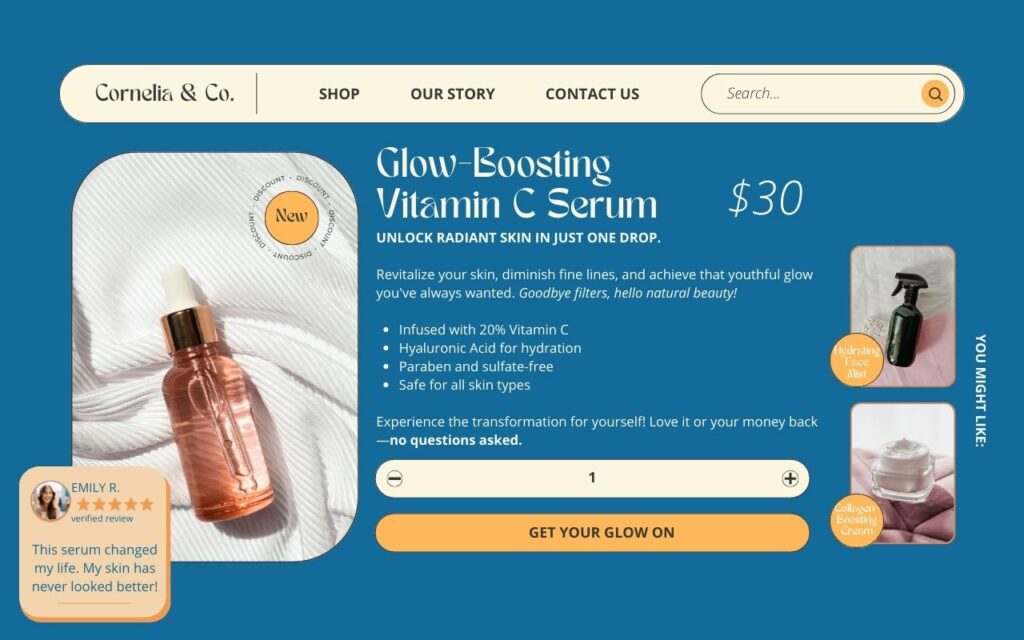
Remember, templates can be excellent launching-off points for product description writing, but as Christina points out, “Every brand’s offerings are unique, which means each description should be unique.”
So, when it comes to templates, use these tips as ground zero for inspiration and consistency. Then, unleash your creative brilliance to make them shine.
One more pro tip? Keep different platforms/mediums, like e-commerce sites and social media ads, top of mind.
Christina explains:
“We do extensive research upfront to understand an audience and its specific personas; that way, the tone migrates seamlessly across various mediums. There are also character limits and mediums that command certain formats.”
For instance, Instagram and LinkedIn can be more informative, whereas TikTok should have bite-sized titles within the video ads and shop listings. Regardless of the medium, she recommends going far beyond a copy/paste strategy to tailor the best story for each platform’s audience.
Time for a taste of the real deal.
Best Selling Product Description Examples
You’ve heard us go on and on about the art and science of how to write product descriptions. But let’s be real—nothing drives a point home like seeing it in action.
We scoured the digital universe to bring you scroll-stopping product description examples that hit all the right marks:
1. Glossier You
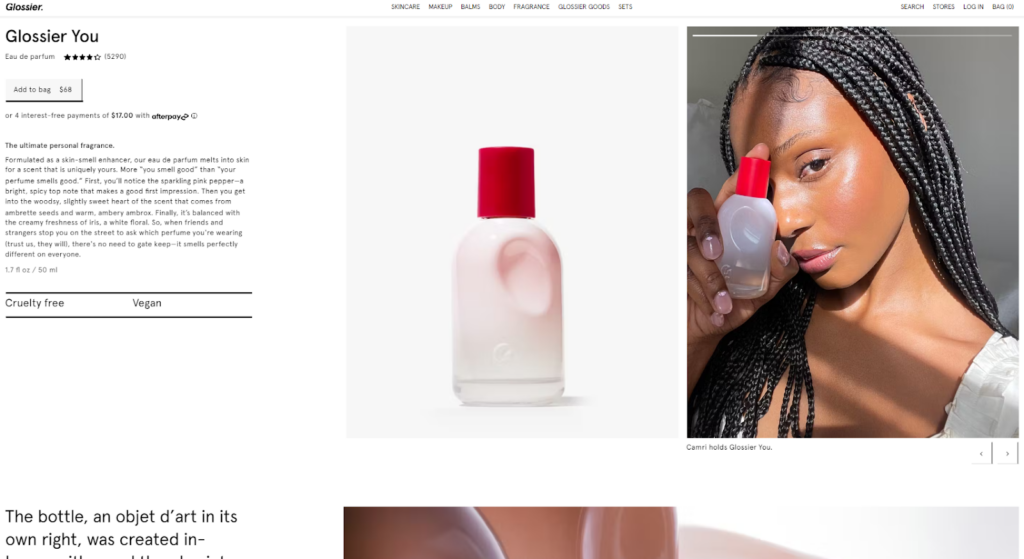
When it comes to packaging an experience into words, Glossier nails it.
They go beyond just listing fragrance notes, framing their eau de parfum as a “skin-smell enhancer.” This elevates their product from a mere fragrance to a personalized beauty ritual. Phrases like “melts into skin for a scent that is uniquely yours” tap into the desire for individuality and personalization.
Using evocative language like “sparkling pink pepper” and “creamy freshness of iris,” Glossier crafts a sensory journey for readers. And they don’t stop at scent—they even touch on the thoughtfulness behind their bottle design.
Their product page dazzles with crisp images, gorgeous videos, and glowing testimonials from fans of the fragrance. Talk about #ProductDescriptionGoals.
2. Nike Air Force 1 Shadow

Right off the bat, it’s clear Nike’s honed in on their target audience, speaking directly to those who appreciate a unique twist on a classic.
Peep this bit: “Make every step unique. These kicks put a playful twist on a hoops icon by doubling up on everything you love about the AF1.” What a perfect example of effortlessly blending storytelling with the product’s UVPs!
Speaking of UVPs, they lay ‘em on thick, all while weaving them into an engaging narrative. They talk about layered textiles and how they’re “designed for performance hoops,” giving you a full 360-degree view of why this shoe is worth the $130 price tag.
It’s not just telling—it’s selling.
3. MD GLAM’s Hyaluronic Acid Night C-Complex
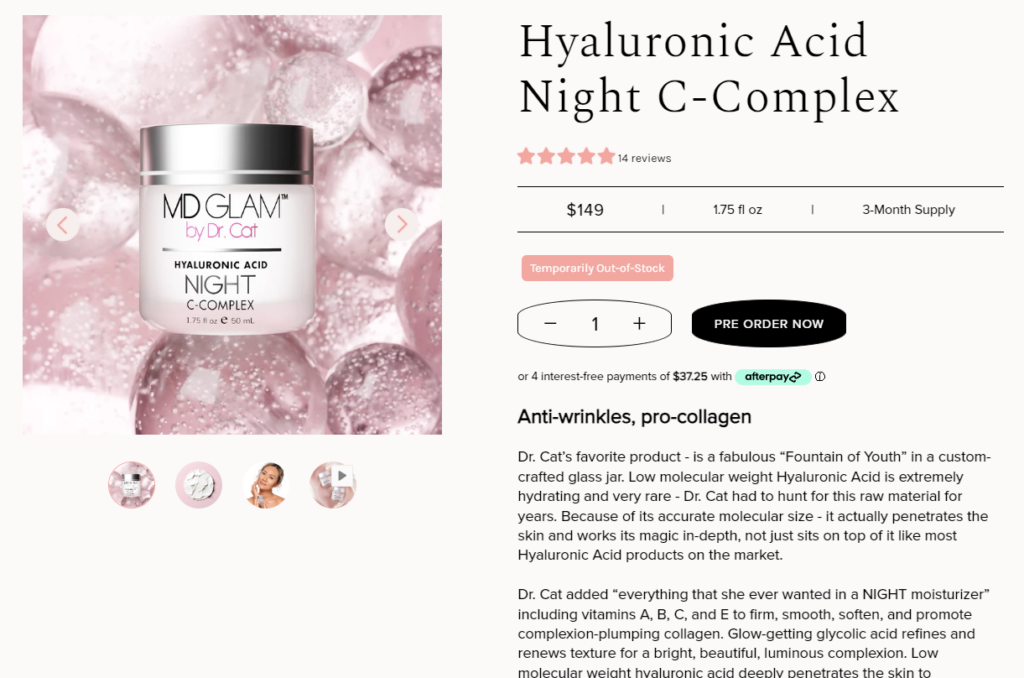
Our client, MD GLAM, infuses language that strikes the perfect balance between scientific and accessible, targeting high-end skincare aficionados who crave medical-grade quality.
Just look at that first line; when the company’s founder says this is their favorite product, you better believe people will pay attention. And that phrase, “Fountain of Youth?” It instantly conjures images of eternal beauty and ageless skin. Now, it’s more than a product—it’s a promise of transformation.
MD GLAM’s UVPs are clear and wrapped in benefits. For instance, “This luxurious experience is suitable for all skin types” shows you’re getting inclusive luxury. And let’s not overlook the “custom-crafted glass jar.” Sure, it’s eco-friendly, but it also exudes an air of quality and sophistication that’s hard to ignore.
Takeaway
These three product descriptions aren’t just ticking boxes—they’re setting the whole damn checklist on fire. They’re serving up benefits on a silver platter, tailored to the exact tastes of their dialed-in audience. From eye-popping visuals to captivating storytelling to a full-circle sensory experience, they’ve got it all.
So, take notes, besties, because these are the gold standards you’ll want to pepper into your product descriptions starting NOW.⚡
Cue the Victory Lap: Your Descriptions, Your Win!
Alright, you’ve got the playbook for how to write product descriptions that shake sh*t up in the best way, but let’s keep it 💯: execution is everything.
You can have all the tips and tricks in the world, but applying them in a way that’s authentically you? Now, that’s where the magic happens.
So go ahead, take what you’ve learned, and make it your own. Experiment, tweak, and don’t be afraid to let your brand’s freak flag fly.
But remember, even the best players need a team. If you’re looking to truly elevate your product descriptions and make “add to cart” the most clicked button on your site, we’ve got you covered. 😉
Book a discovery call today and let the fiercest writers in the biz make you a sensation.⭐

10/05/2023
Natalie is a beauty and lifestyle writer at Lyon Content, born and raised in sunny Miami, Florida. She’s passionate about crafting personality-driven copy that helps brands build a ride-or-die following with their audiences! Like a true Cuban, she runs on XL cafe-con-leches and loves horror movies, houseplants, exploring new places, and snuggling up with her SO and fur babies.

